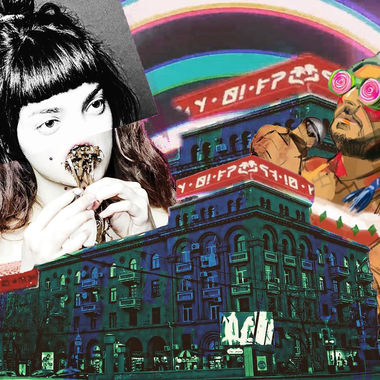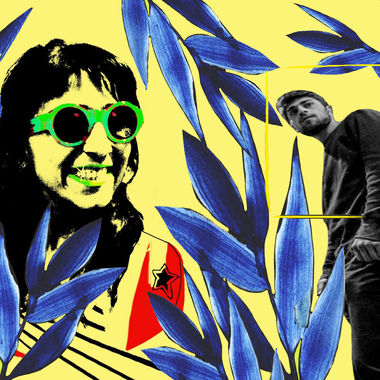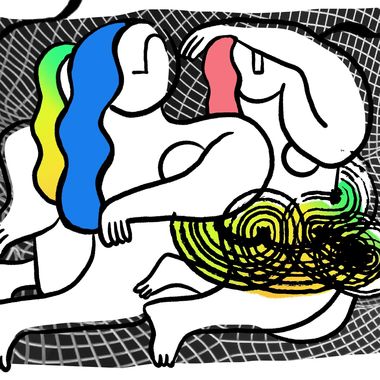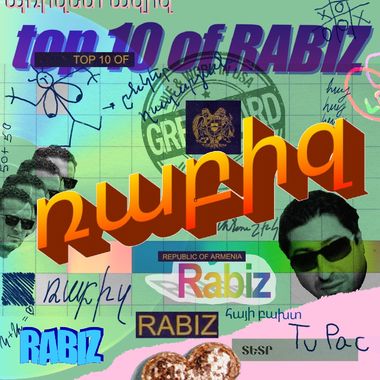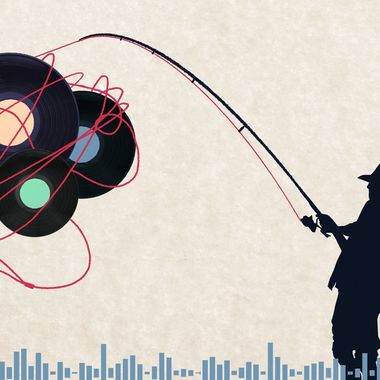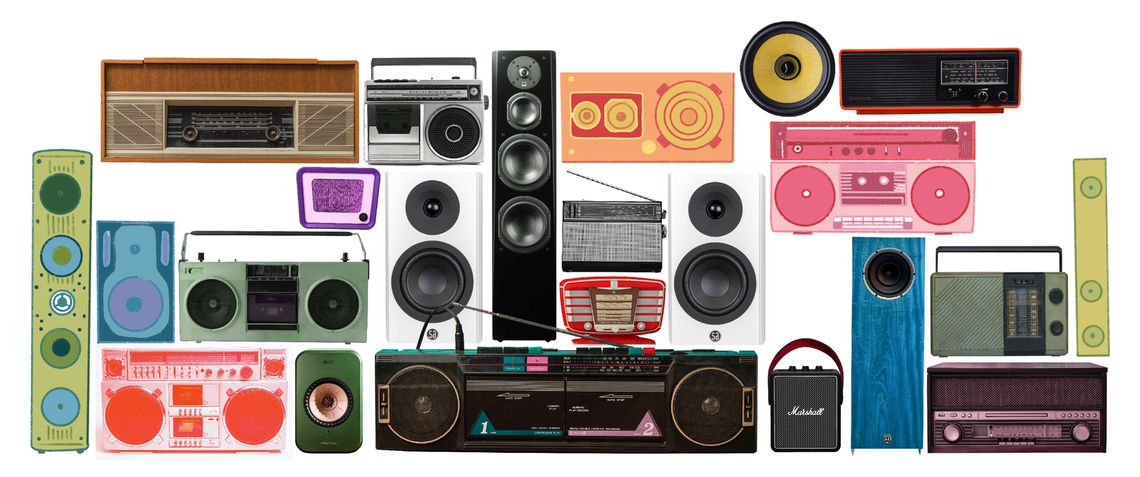
Illustration by Armine Shahbazyan.
In 2018, EVN Report published two pieces featuring seven artists from the Armenian underground music scene. Much has changed in Armenia and globally in the past three years. But less so when it comes to the underground. Despite the many challenges, old and new artists continue to create and represent this essential music scene.
There’s a loose understanding of underground music that most people seem to be on board with, which is that if one is not popular or mainstream then they are in the underground. Each artist, however, has a different relationship with the concept of the underground. Some are trying to break out of the “label,” others say their goal is to go from the underground “to the overground” without compromising their art and caving into commercialization and some simply appreciate the comfort that comes with performing in intimate settings
Here are four more individual and group artists who, in their own ways, are paving the way for the future of local and regional music.
Khndzori Sok
The story of Khndzori Sok (which translates into Apple Juice) goes back to not-very-distant 2013, when Em and a few of his friends decided to cover a Russian song for an event at Mashtots Park, and something “clicked.” That motivated them to perform more regularly, mainly at pubs. Soon after, Em was enlisted to serve in the army, but that didn’t stop him from making music. He met Vova there, who would later temporarily become his band’s bassist. Over the last two years, however, Khndzori Sok has transformed from a group to a solo act: Em and his guitar.
Why Khndzori Sok?
“Because why not? I just liked the cynicism of the name and what I could do with it.”
Em explained that a positive image would generally come to mind when someone hears the name Khndzori Sok, but when they listen to the music, recently expanded into progressive metal, they would be taken aback.
In fact, his music is both thematically and sonically not too heavy, nor too light. It’s the kind of alternative/indie rock that anyone can listen to. Then again, Em doesn’t like classifying his music as one way or another. “Things might change in the future, I might experiment with hip hop/rap,” he said.
If Khndzori Sok were a fruit, which fruit would it be, and why?
For someone whose group name is fruit-inspired, the answer to this question was obvious but after pausing for a moment, Em said, “Apple, but the sour green kind.” In fact, for a while, Em changed the name of his act to “Ttvadz (Sour)” on Facebook, before changing it back to its original, sweeter name.
Is there an individual, song or text that you’d say has strongly influenced your work?
“The American rock band Black Rebel Motorcycle Club (BRMC) became the source of my inspiration from an early age, whose influence is reflected in my overall music,” said Em. Tool, Porcupine Tree, Dream Theater are some of the other groups he’s drawn inspiration from, in addition to Quentin Tarantino’s filmography.
Khndzori Sok - Թույներ / Poison
Symptom
Sona and Amassia started making music so they wouldn’t fail out of school. Their high school music teacher, Kay (aka Nystagmus), taught them how to use the Ableton music production software to complete the credits they needed to graduate. That led them to experiment and fall in love with electronic music.
Their first concert took place on the rooftop of their school, with an audience full of kindergarten kids and Sona’s mom. But Sona and Amassia soon gathered their energy and secured themselves their first real gig at Calumet, alongside LSD, in 2017.
Not having an official group name, the event organizers initially put their act name down as “Kay’s Girls” (after their teacher), which they thought was horrible. So with only a few hours before hitting the stage, (Not) Kay’s Girls had to somehow come up with a name. Amassia was reading a book at the time. They decided to turn to a random page, Sona put her finger on the word “symptom” and the rest was history.
Sona and Amassia, like Em, try to avoid the concept of genre to give themselves “the freedom to explore all kinds of sounds.” “It depends on our emotions, what we’re personally going through,” Sona explained. “Our look has also changed over time,” added Amassia.
If you were to compare your sound to a fruit, which fruit would it be and why?
Sona and Amassia perhaps provided one of the most interesting definitions of a dragon fruit. Sitting with the question for a moment, they said, “There’s this exotic pink fruit, when you cut it, it’s black and white from the inside. It's unstable from the outside but stable from the inside,” which they seemed to relate with.
Is there an individual, song or text that you’d say has strongly influenced your work?
“I’ve drawn a lot of inspiration when it comes to writing from the American feminist punk movement, Riot Grrrl, and specifically from Kathleen Hanna, who has helped me perform,” said Amassia. Whereas, Marilyn Manson and Chelsea Wolfe are among those who Sona admires, the former acting as a catalyst in shaping her personality, to trust herself and to make her want to be more confident and say to others, “This is who I am, do whatever you want.”
Symptom - Փշաքաղ / Pshaqagh
NODE
Ani and Vardan (aka DUKE) both happened to attend another LSD concert in Dilijan on a late spring day in 2017. Finding a guitar laying in a corner at an afterparty, Ani started playing and immediately captured Vardan’s attention. That’s how their collaboration started.
Their group name came about just as coincidentally as their meeting. They were searching for a cool, memorable name and they eventually settled on NODE. “It signifies finding new connections, just like a node does,” explained Ani. “We initially wanted to name it ‘Wet Bandits’ after Home Alone, but we later changed our minds.”
Ani and Vardan, who now make electronic, specifically synthwave, music might also change their mind about their sound in the future. “The genres change. Now it’s synthwave, before it was different, and the future is unknown,” said Vardan. “It depends on our feelings,” added Ani - echoing Symptom and Khndzori Sok.
If NODE were a fruit, which fruit would it be?
After a long pause, “Mandarin,” blurted Ani. “It’s my favorite.” And Vardan, who earlier described their music as “unusual,” laughed and said, “Yeah, that’s a good one!”
Name an individual, song or text that you’d say has strongly influenced your work?
“A lot of situations/people have influenced me at different times,” said Ani. Vardan pinpointed the synthwave scene of the last few years as a great influence generally. “And Nico, who is our mother,” he added, making Ani laugh, referring to the late Christa Päffgen who is better known by her stage name, Nico.
NODE - Dance (from the album Thought Infection)
Aveluk
Zara’s musical journey also began to take shape during her school years, when she was trained to play the violin and wrote short stories and essays on her own. But she only started to write songs and sing when a friend taught her how to play the guitar at university.
After putting on private shows for her friends for a while, one day she decided to post an original song (ինձ համար հեշտ էր / It was easy for me), which she recorded on her phone and posted it on YouTube. She had to pick a name for her channel and “Aveluk” (a green herb eaten in the region) was the first thing she thought of.
Zara forgot about the song and moved on, but after visiting her YouTube page a few months later, she was surprised to discover her track had thousands of views. That’s what made her put out music and perform more regularly. Starting in 2013, she now has a catalog of more than 40 original songs on her channel.
Is there an individual, song or text that you’d say has strongly influenced your work?
Before attending university, where she studied painting, she was also involved in theater. “I met a director there who introduced me to the Theatre of the Absurd. That led me to understand what I wanted to write and how to express myself,” said Zara. Russian rock has also had a great impact on Zara’s creative production. She mentioned Aquarium/Akvarium, Piknik and Splean among the bands that have directly influenced her music.
That being said, Zara too, like the rest, hasn’t put much thought into classifying her music and doesn’t plan to. As a master of acoustic music, she now wants to explore electronic music alongside what she knows best. That’s what led her to collaborate with Kay (yes, the same guy who brought Symptom’s Amassia and Sona together). They recently released a new track together called “Բանալիները մեր տան / The keys to our house'' in response to the 2020 Artsakh War.
If Aveluk were a fruit, which fruit would it be?
“What do I know? Cucumber was the first thing that crossed my mind although it’s not a fruit,” said Zara laughing. Her answer, like Em’s, was expected too. After all, how could a herb-based sound be a fruit?
Kay&Aveluk - Բանալիները մեր տան | The keys to our house
Related Articles
Underground / Ընդհատակ
By Ani Yavrenc
The stages of the underground are hidden but colorful. The bohemian of the underground creates its own, paints it in colors and like a mad person does not deviate from its unconventional path. Ընդհատակի բեմերը փակ են, բայց գունավոր: Ընդհատակի բոհեմն ստեղծում է սեփականը, գունավորում այն ու ծալապակասի պես նստած՝ շարունակում արվեստը։
Underground /Ընդհատակ/ II
By Ani Yavrenc
There is art underground. It is beautiful and that is probably why it is hidden. Meet Armenia's underground musicians through EVN Youth Report's series. Ընդհատակում արվեստ կա։ Գեղեցիկ է ու ընդհատակ է անցել։ Ծանոթացեք ընդհատակի փախած կերպարների հետ EVN Youth Report- ի միջոցով:
The EDM Kitchen։ Electronic Dance Music in the Context of Gender
By Eva Khachatryan
Electronic dance music, as a relatively new cultural phenomenon, could have been occupied by women, but even here, the presence of men is predominant and women have to fight for fair representation.
“Michael Jackson, Know This Well, I Can’t Bear This Pain”
By Karen Avetisyan
The “Top Ten of Rabiz” was a series of albums produced by a group of young men trying to reproduce the scattered reality of the 1990s through the language of music and an experimental format that was never really “rabiz.”
Armenia’s Path to Getting Copyright Right
By Hovsep Markarian
Artists have been facing a real problem in Armenia: not getting fairly compensated for the music they release. In an age when sales of physical disk copies have drastically declined, with concerts and tours put on hold because of a pandemic, how are musicians supposed to get by?
Retro Sounds in a Digital Format
By Gayane Ghazaryan
What happens when we search Armenian artists from the 20th century on the Internet? If we’re lucky, we might find a video or two and bits of information. It’s not because Armenia doesn’t have its legacy in folk music, jazz or classical music but because the tunes have been locked away in archives, something that is about to change.
New Music: A Conglomerate of Ideas and Solutions
By Artur Avanesov
What is New Music and why is it not thriving in Armenia? According to composer and musician Artur Avanesov, New Music is a vibrant conglomerate of ideas and solutions, a vast network of communications, pretty much like a modern metropolis; it pushes boundaries and is a search for new sounds and forms.


